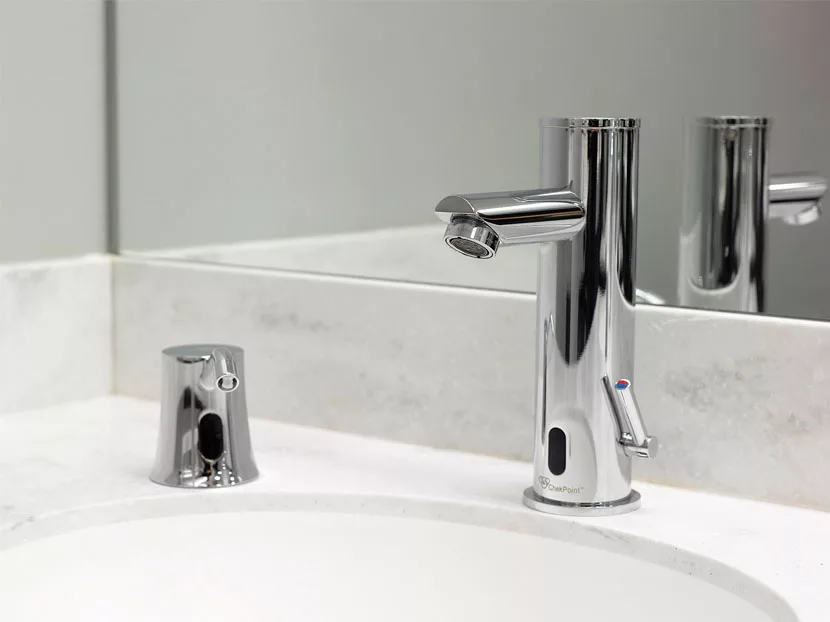Pay attention as you visit public restrooms, and you may notice the signs of a growing trend. Hands-free devices are cropping up everywhere, from airports and sports stadiums to office buildings, hospitals and schools. They’re in the local library, your doctor’s office and the roadside rest area.
Sensor-operated devices, particularly faucets and flush valves, have been proliferating for the past several years as operators recognize the benefits, users appreciate the experience and technology has advanced to keep everyone happy.
The rise in hands-free
The explosion in popularity of hands-free devices has been driven primarily by user preference.
Everyone is familiar with the experience of walking into a poorly maintained restroom and desperately trying to avoid having to touch anything for fear of germs. We kick toilet handles to flush — a move that’s hard on the flush valve — and use paper towels or elbows to keep hands off of faucets or door handles.
Even in a clean, well-kept facility, the experience of waving your hand to start washing up feels cleaner, — and more modern — than a traditional faucet handle.
Still, despite this preference, building operators and owners might have been reluctant to upgrade to sensor devices if it weren’t for the tangible benefits they offer, including reduced water use and waste and improved hygiene, particularly in food- and health-related settings.
Sensor faucets can save up to one gallon of water per handwashing over traditional manual faucets. Combine water costs with sewer charges and the energy to heat the water, and the potential financial ramifications of water conservation can add up.
Additionally, hands-free devices are less prone to the kind of vandalism or neglect sometimes seen in high-volume settings, where a faucet is left to run unchecked, pouring hundreds of gallons of water down the drain. Thanks to auto-shut-off technology, sensor faucets can be programmed to stop running after a set period, regardless of whether someone has tried to cover or otherwise manipulate the activating sensor.
In facilities where hygiene is a leading concern, hands-free devices reduce the risk of contamination from handles. A study recently published in the journal Risk Analysis (bit.ly/2psmqva), a publication of the Society for Risk Analysis, identifies the installation of touchless faucets and doors as a factor in reducing the transmission of norovirus in food establishments.
Nearly every industry has seen at least some growth in the use of sensor faucets as customers have gotten more familiar and more comfortable with them — and in some cases come to expect the high-end experience associated with them.
Sensor faucets can be valuable in almost any applications but are ideally suited for high-volume settings like airports, event venues and quick-serve and casual restaurants, and for office buildings and other facilities seeking to portray a premium image.
Technology
Hands-free devices likely would not be experiencing their current boom if not for the advances in technology that have made them more functional and more attractive than ever before.
When hands-free fixtures were first introduced, they were often bulky and aesthetically unappealing. As they’ve evolved to occupy a more premium spot in the marketplace — and are gradually taking the place of manual faucets in many applications — manufacturers have worked to meet consumer demands by creating streamlined, more desirable styles.
Architects and other designers have taken note of the visual appeal and found them to be great-looking options for many restrooms where they might have previously chosen a more traditional option.
In addition to appearance, function has improved over time. Sensors are more effective. Electronics are less obtrusive. And power supplies are more reliable.
Manufacturers have introduced long-life batteries or hydrogenerators, which power the faucet through a water turbine-driven power supply and, that require less ongoing maintenance to keep faucets in good working order.
Advancements in low-flow technology and features such as auto-flush, which automatically runs water after a period of inactivity to prevent stagnation and bacteria accumulation, have made sensor faucets more appealing for a wider array of applications.
The future may hold even more developments in hands-free devices that could continue to fuel their growth. The kind of connectivity and smart bathrooms currently being introduced in residential applications may soon spread to commercial settings, making commercial applications more efficient than ever before.
Getting the most from hands-free
For all the performance benefits that hands-free devices can offer, getting the most out of them requires attention to a few simple steps.
First and foremost, specify a quality product. In almost any commercial setting, faucets will face a significant amount of wear and tear. Starting with a durable product means you get the best performance for the longest time, lowering the total cost of use over time versus regularly replacing cheaper products.
Establish a regular maintenance schedule. A dead battery that prevents a faucet from operating leads to a negative user experience. Check aerators periodically for a buildup of calcium or deposits that can lead to restricted water flow.
This may go without saying, but be sure to read the instructions during installation to ensure the setup is completed correctly. Different manufacturers have different ways of accommodating the environment the faucet is going to be in.
For example, some have automatic sensor adjusting; others require manual adjustment. Other functions, like shut-off and auto-flush features, or the temperature mix may need to be set or programmed at installation.
Once hands-free fixtures are installed correctly, they are often trouble-free devices that require little maintenance and offer experiential, tangible and financial benefits for users.
David Scelsi is a marketing product manager with T&S Brass.





